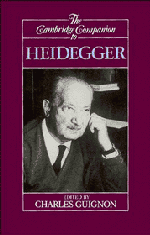Book contents
- Frontmatter
- Introduction
- 1 The question of being
- 2 Reading a life
- 3 The unity of Heidegger's thought
- 4 Intentionality and world
- 5 Time and phenomenology in Husserl and Heidegger
- 6 Heidegger and the hermeneutic turn
- 7 Death, time, history
- 8 Authenticity, moral values, and psychotherapy
- 9 Heidegger, Buddhism, and deep ecology
- 10 Heidegger and theology
- 11 Heidegger on the connection between nihilism, art, technology, and politics
- 12 Engaged agency and background in Heidegger
- 13 Wittgenstein, Heidegger, and the reification of language
- Bibliography
- Index
11 - Heidegger on the connection between nihilism, art, technology, and politics
Published online by Cambridge University Press: 28 May 2006
- Frontmatter
- Introduction
- 1 The question of being
- 2 Reading a life
- 3 The unity of Heidegger's thought
- 4 Intentionality and world
- 5 Time and phenomenology in Husserl and Heidegger
- 6 Heidegger and the hermeneutic turn
- 7 Death, time, history
- 8 Authenticity, moral values, and psychotherapy
- 9 Heidegger, Buddhism, and deep ecology
- 10 Heidegger and theology
- 11 Heidegger on the connection between nihilism, art, technology, and politics
- 12 Engaged agency and background in Heidegger
- 13 Wittgenstein, Heidegger, and the reification of language
- Bibliography
- Index
Summary
Martin Heidegger's major work, Being and Time, is usually considered the culminating work in a tradition called existential philosophy. The first person to call himself an existential thinker was Soren Kierkegaard, and his influence is clearly evident in Heidegger's thought. Existential thinking rejects the traditional philosophical view, which goes back to Plato at least, that philosophy must be done from a detached, disinterested point of view. Kierkegaard argues that our primary access to reality is through our involved action. The way things show up for a detached thinker is a partial and distorted version of the way things show up to a committed individual.
Kierkegaard defines the self as a relation that relates itself to itself. That means that who I am depends on the stand I take on being a self. Moreover, how I interpret myself is not a question of what I think but of what I do. I have to take up what is the given or factical part of my self and, by acting on it, define who I am. I understand myself as being a student, a teacher, the lover of a specific person, or the follower of a specific cause. Thus, the self defines itself by taking up its past by means of present actions that make sense in terms of its future. For Kierkegaard, then, the self can be understood as a temporal structure.
- Type
- Chapter
- Information
- The Cambridge Companion to Heidegger , pp. 289 - 316Publisher: Cambridge University PressPrint publication year: 1993
- 47
- Cited by

